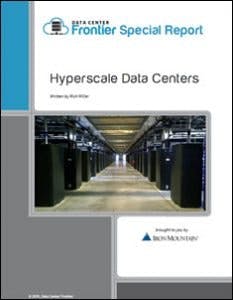Reshaping the Global IT Landscape: The Impact of Hyperscale Data Centers
Data Center Frontier continues to explore the fastest growing markets and niches in the data center market via our DCF Special Reports. This time around, Data Center Frontier partners with Iron Mountain to explore the hyperscale data center market, and how its growth has changed how we compute. This excerpt from a recent Hyperscale Data Center report dives into the impact of hyperscale computing.
Download the full report.
The hyperscale data center is reshaping the global IT landscape, shifting data from on-premises computer rooms and IT closets to massive centralized data center hubs. Workloads are consolidating in the world’s largest and most efficient facilities. These cloud campuses offer economies of scale, enabling hyperscale operators to rapidly add server capacity and electric power.
It has become routine for these hyperscale companies —especially the top tier of Amazon Web Services, Google, Facebook, Microsoft and Apple—to invest $1 billion to $3 billion in a single campus.
The growth of hyperscale cloud campuses is part of a larger densification of America’s IT infrastructure, which features data centers in many new places. This digital transformation will create layers of distributed infrastructure, from the core to the edge of the network.
In the process, the rise of hyperscale computing has created a new paradigm in the data center business. Hyperscale companies have become the largest customers for leasing wholesale and build-to-suit data center space. As a result, these customers hold huge sway over data center development, which has evolved rapidly to adapt to hyperscale requirements.
In this special report, we will examine how hyperscale data centers have changed how we compute, how data center space is built and sold, and has altered the supply chain for digital infrastructure. We also share Data Center Frontier’s take on how hyperscale computing will evolve in the future.
The Hyperscale Transformation
As the name suggests “hyperscale” is defined primarily by scale. Everything about hyperscale computing is bigger, and is optimized to process, store and transport massive amounts of data. The hyperscale operator is providing IT services for millions and even billions of users.
The scale of these businesses requires large data centers. Their global scope requires a distributed network of these large data centers, and low-latency connectivity between them.
The rise of hyperscale computing is driven by the benefits it provides to customers and operators. There are four huge trends influencing this growth:
- Cloud Computing, which allows users to shift their IT operations to a service model, with remote data centers housing data and applications, which can run from an app or web browser.
- Social Media, which has transformed modern communication, allowing individuals to connect with distributed networks of friends and family. Social media has also become a powerful marketing and audience-building tool for businesses and non-profit organizations.
- Software Platforms, which are disrupting multiple industries, using software and logistics to streamline the sale and delivery of products and services. Software is “eating the world” and in the process it is creating streams of data that must be stored and analyzed.
- Content Delivery, including global distribution of “over the top” streaming video, and the explosive growth of eSports and cloud-hosted gaming platforms.
This digitization of our economy is projected to generate an ocean of data, fed by a growing universe of intelligent things—sensors, cameras, smartphones, tablets, drones, robots and connected cars. IDC predicts that the “global datasphere” will grow from 33 zettabytes (ZB) in 2018 to 175 ZB by 2025.
Cisco predicts that machine-to-machine (M2M) applications will account for 51 percent of the total devices and connections by 2022. On the consumer end, use of video is growing, both in social sharing and “over the top” delivery of streaming media.
Almost no one is using less data today then they did yesterday. They will consume even more data tomorrow.
Some of the world’s largest and most sophisticated investors are pumping money into the sector, perceiving a long-term growth opportunity in digital infrastructure.
The primacy of data is a secular trend that has been building for years and will only accelerate with the arrival of next-generation technologies like artificial intelligence (AI), the Internet of Things and augmented reality. 5G wireless will move data with higher speed and greater volume.
The response has been a growing industrialization of digital infrastructure, as data center developers optimize every component of the network, from subsea cables all the way down to the chips on server boards. When applied at scale, these optimizations ripple across huge facilities and platforms, making infrastructure more efficient and affordable.
As a result, hyperscale computing is attracting significant investment. Google, Amazon, Microsoft and Facebook all have in-house R&D programs to design custom silicon for servers and network equipment. Meanwhile, some of the world’s largest and most sophisticated investors are pumping money into the sector, perceiving a long-term growth opportunity in digital infrastructure.
The trends are neatly summed up by analyst and tech executive Bernard Golden: “Simply put, we are on the cusp of an enormous transformation as computing resource provisioning transitions from expensive and complex to cheap and low-friction.”
The hyperscale data center has emerged as the physical form factor to power this digital transformation. In the process, it is bringing significant change to the data center industry.
Over the next few weeks, don’t miss further articles in the Hyperscale Data Center Market report that will cover:
- Who are the hyperscale players, and the concept of build vs buy
- How a hyperscale data center is different and the geography of hyperscale data centers
- The future of hyperscale
Download the full report, “Hyperscale Data Centers,” courtesy of Iron Mountain Data Centers, to learn more about how hyperscale computing has changed the supply chain for digital infrastructure, and how this computing shift will evolve.
About the Author




